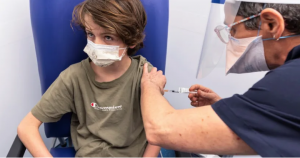British Medical Journal: Flu vaccines seem to be modifying influenza into a dangerous dengue-like disease


The British Medical Journal, or BMJ, is one of the top websites in the world and one of the oldest medical journals, at 170+ years.
I’m shocked to see that they’ve published this.
I actually did a post when cardiologist and BMJ editor in chief, Pascal Meier MD, followed me on Twitter. It appears he follows me on two different accounts. It says online he lives in Geneva. Never thought to ask my birth mum scientist (who lives there too, Dr. Kemf) if they know one another.
Now, just look what they published just days ago. This might be groundbreaking, even revolutionary. The BMJ source is linked at the bottom of this article.
Kudos to the author.
Here’s one quote that is quite eye-opening:
When a person making anti-H3N2 IgE is infected with H3N2, one can expect the course of the flu to be significantly worse. So the “cytokine storm” being observed in severe cases is likely to be an infection concurrent with an allergic reaction. Death is caused by anaphylactic shock but due to the presence of an infection, it is wrongly classified as septic shock.
And here’s the whole enchilada:
Influenza vaccines seem to be modifying influenza into a dangerous dengue-like disease
Last year’s influenza vaccine also contained the same H3N2 strain as this year’s vaccine (A/Hong Kong/4801/2014 (H3N2)-like virus). Many people would have developed long term IgE mediated sensitization to the H3N2 viral proteins due to last year’s vaccine [1–4]. Those who received the Flublok vaccine can be expected to have an even stronger IgE response due to its 3X viral protein content [5,4]. This year’s vaccine H3N2 proteins would have been neutralized by these IgE antibodies. Thus resulting in the observed low vaccine efficacy. [6]
When a person making anti-H3N2 IgE is infected with H3N2, one can expect the course of the flu to be significantly worse. So the “cytokine storm” being observed in severe cases is likely to be an infection concurrent with an allergic reaction. Death is caused by anaphylactic shock but due to the presence of an infection, it is wrongly classified as septic shock.
In the case of food allergy for example, the allergen exposure can be large enough to cause an immediate hypersensitivity reaction and anaphylactic shock within minutes/hours. In the case of influenza allergy, it may take a day or two for the virus to replicate and produce enough viral exposure for anaphylaxis. So the anaphylaxis unfolds over a couple of days.
“Self-reported vaccination for the current season was associated with a trend (P < 0.10) toward higher viral shedding in fine-aerosol samples; vaccination with both the current and previous year’s seasonal vaccines, however, was significantly associated with greater fine-aerosol shedding in unadjusted and adjusted models (P < 0.01). In adjusted models, we observed 6.3 (95% CI 1.9–21.5) times more aerosol shedding among cases with vaccination in the current and previous season compared with having no vaccination in those two seasons.” [7]
This result makes a lot of sense. When you have influenza virus allergy and are infected, you have more mast cell degranulation, more histamine, more mucus, more sneezing, more viral shedding.
Increased hospitalization rates have been observed in asthma patients that have received the influenza vaccine. Again, this is as predicted because asthma patients are likely to produce stronger IgE responses to the viral proteins upon vaccination. [8] On subsequent virus exposure, they can be expected to develop severe IgE mediated asthma.
Consider dengue infection. The initial mosquito bite that injects dengue virus into a person, causes the induction of IgE against dengue proteins. [9] Upon a subsequent bite that introduces the dengue virus again, the person develops hives due to a dengue specific-IgE mediated allergic reaction. As the infection (and thus allergic reaction) progresses and more histamine is released, vascular permeability increases. The result is hypotension and dengue shock syndrome. [10] Basically, a type 1 hypersensitivity reaction caused upon dengue virus exposure following IgE mediated sensitization to dengue viral proteins.
The route of exposure for natural influenza infection is the respiratory tract, not subcutaneous (SC) or intramuscular (IM) injection. Influenza vaccines artificially changed the route of initial viral protein exposure to SC or IM injection thus making it similar to the route of exposure for dengue. The result is an IgE response to influenza proteins, similar to the response for dengue. It should therefore not come as a surprise that we are modifying the course of influenza infection such that it is acquiring characteristics of a dengue infection (hives and shock).
As a result, allergy medications such as antihistamines and anaphylaxis treatments may have to be considered to avoid or treat this man-made influenza shock syndrome.
References
1. Smith-Norowitz T a, Wong D, Kusonruksa M, Norowitz KB, Joks R, Durkin HG, et al. Long term persistence of IgE anti-influenza virus antibodies in pediatric and adult serum post vaccination with influenza virus vaccine. Int J Med Sci. 2011;8(3):239–44.
2. Davidsson A, Eriksson JC, Rudblad S, Brokstad KA. Influenza specific serum IgE is present in non-allergic subjects. Scand J Immunol. 2005 Dec;62(6):560–1.
3. Nakayama T, Kumagai T, Nishimura N, Ozaki T, Okafuji T, Suzuki E, et al. Seasonal split influenza vaccine induced IgE sensitization against influenza vaccine. Vaccine. 2015;
4. Arumugham V. Short sighted influenza control policy based on poorly designed vaccines will sicken more people [Internet]. Available from: https://www.zenodo.org/record/1038445
5. Corporation PS. Flublok Quadrivalent 2017-2018 [Internet]. 2018. Available from: https://www.fda.gov/downloads/BiologicsBloodVaccines/Vaccines/ApprovedPr…
6. McLean HQ, Thompson MG, Sundaram ME, Meece JK, McClure DL, Friedrich TC, et al. Impact of repeated vaccination on vaccine effectiveness against influenza A(H3N2) and B during 8 seasons. Clin Infect Dis. 2014;59(10):1375–85.
7. Yan J, Grantham M, Pantelic J, de Mesquita PJ, Albert B, Liu F, et al. Infectious virus in exhaled breath of symptomatic seasonal influenza cases from a college community. Adamson W, Beato-Arribas B, Bischoff W, Booth W, Cauchemez S, Ehrman S, et al., editors. Proc Natl Acad Sci. National Academy of Sciences; 2018;
8. Joshi AY, Iyer VN, Hartz MF, Patel AM, Li JT. Effectiveness of trivalent inactivated influenza vaccine in influenza-related hospitalization in children: a case-control study. Allergy asthma Proc. United States; 2012;33(2):e23–7.
9. Koraka P, Murgue B, Deparis X, Setiati TE, Suharti C, Van Gorp ECM, et al. Elevated levels of total and dengue virus-specific immunoglobulin E in patients with varying disease severity. J Med Virol. 2003;70(1):91–8.
10. Tuchinda M, Dhorranintra B, Tuchinda P. Histamine content in 24-hour urine in patients with dengue haemorrhagic fever. Southeast Asian J Trop Med Public Health. Thailand; 1977 Mar;8(1):80–3.
Competing interests: No competing interests
Click here for the author and other information.
SOURCE: British Medical Journal










Interesting Article – Wolf Street – Update on the Busted Housing Bubble in Sydney & Melbourne by Wolf Richter.
If anyone had money & was thinking about purchasing real estate – now might be the time.
You are going to love this – There Are No Sunglasses – Canada Exhausts Entire Inventory of Legal Pot in 2 Days …. New Production Goal of 1 Million Pounds.
Trump can’t but help but see the dollar signs when he sees the untapped potential depicted on the map below.
Article features a map.
UBER is going to become filthy rich delivering this stuff.
E&E Hospital Gibson St East Melb.
Overnight stay.
Bring: nightwear, toiletries, tissues & medication in boxes.
The E&E are totally disorganised.
They book & double book appointments – they book & the cancel & rebook on a different day constantly.
This is not just me but everybody – they turn up according to their astrological readings – if the stars say ‘beware’ they stay home.
I turned up 6:33am for 7:00am eye surgery, I was processed – at 10:30am they were making noises about my surgery being cancelled – 11:15am a nurse told me that my surgery was cancelled but please wait so that the doctor can speak to you – 1245:00pm the doctor appeared.
I BOOKED RESPITE & LOST MY DEPOSIT as a result – like I have hundreds of dollars to flush down the toilet.
My condition was far more serious than they had originally thought & I needed to go to main hospital Gibson St & stay overnight.
IF THEY HAD PROCEEDED WITH THE SURGERY I would have been butchered.
My surgery should have been done over 2 months ago – they have stalled & procrastinated – who cares if I go blind – right.
All of these cancelled appointments cost time & money – the hospital is working at a snail’s pace costing the Victorian Taxpayer Millions of Dollars.
The long waiting times for surgery are a big fat “I Can’t Be Stuffed” on the part of the medical professionals – the hospitals are not being used & therefore are costing a small fortune in wasted time – resourced – the doctors & nursing staff ase still paid 7 so are the surgeons.
Australia has 2 1/2 – 3 times more medical professionals than we need AND they are all on the payroll – doing very little or nothing – nowhere, but nowhere else in the world does the medical profession GET PAID TO DO NOTHING except AUSTRALIA.
The above list – bring your own tissues – THEY – THE HOSPITALS GET THE TISSUES FOR NOTHING = THEY ARE FREE + toilet paper & a whole lot of other goodies – all FREE.
The Australian hospital system is HEMORRHAGING MILLIONS UPON MILLIONS OF DOLLARS EACH YEAR.
These are Multi Billion Dollar Facilities & Valuable equipment going to waste.
Because of a bunch of lazy & up their own arse airy fairy pansies.
The Pacemaker that the cardiac surgeon – LaughingFatBoy – put into the top of my left breast has slipped down a couple of inches.
Another cardiac medical professional look at it & told me – “You Have Been Sexually Mutilated” – how am i supposed to feel about that.
I remember that he left the operating theater immediately he completed the surgery.
A desperate dash to MASTERBATE no doubt.